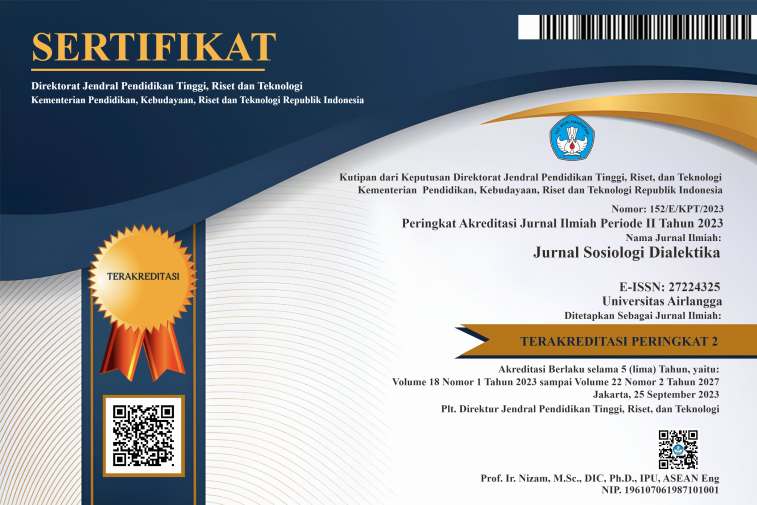Social media activism to reject andesite mining, case of “Wadas Melawan” movement
Downloads
Social media has become a powerful tool for public discourse, enabling users to engage with social issues. This study focuses on social media activism in the Wadas Melawan movement, which opposes andesite mining in Wadas Village, Purworejo, Central Java. Using a qualitative approach, with the using the primary data of Social Media Data that advocate of case the wadas. This research using Qualitative Data Analysis Software (Q-DAS) as analysis parts specific using NVIVO 12Plus, the data from social media analyse in Nvivo 12Plus using indicators coding and presenting the findings through descriptive figures and tables. Findings reveal three main points: first, social media content centers on resistance, violence, and societal impacts. Second, hashtag analysis shows strong correlations among key hashtags, ranging from 0.5 to 1.0. Third, dominant terms such as #WadasMelawan, “Wadas,” and “warga” (villagers) highlight the central role of the community. While the study is limited to Twitter, it suggests future research should explore other platforms for a more holistic understanding. This research emphasizes how social media amplifies grassroots movements and shapes public narratives, showcasing local digital activism against environmental exploitation unlike prior studies that typically focus on national-level movements.
Al-Rawi A, Siddiqi M, Wenham C, & Smith J (2022) The gendered dimensions of the anti-mask and anti-lockdown movement on social media. Humanities and Social Sciences Communications 9 (1). https://doi.org/10.1057/s41599-022-01442-8.
Alexopoulou S & Pavli A (2021) ‘Beneath This mask there is more than flesh, beneath this mask there is an idea’: Anonymous as the (super)heroes of the internet?. International Journal for the Semiotics of Law 34 (1):237-264. https://doi.org/10.1007/s11196-019-09615-6.
Allam Z, Khavarian-Garmsir AR, Lassaube U, Chabaud D, & Moreno C (2024) Mapping the implementation practices of the 15-minute city. Smart Cities 7 (4):2094-2109. https://doi.org/10.3390/smartcities7040083.
Baptista JP, Jerónimo P, Piñeiro-Naval V, & Gradim A (2022) Elections and fact-checking in Portugal: the case of the 2019 and 2022 legislative elections. Profesional de La Informacion 31 (6). https://doi.org/10.3145/epi.2022.nov.11.
Berg A (2023) Feeling misinformation: contours of information enthusiasm. Emotions and Society 5 (3 Special Issue):315-331. https://doi.org/10.1332/26316897Y2023D000000002.
Berger M & Sklansky DA (2023) Crime, community, and the shadow of the virtual. University of Illinois Law Review (5):1607-1656.
Boling KS, Walsh J, Petrotta B, & Stamm J (2025) “Perjurers, rapists, and zealots are ending abortion”: Sports journalists’ symbolic annihilation of women athletes on social media during the national loss of abortion rights. Communication and Sport 13 (2):321-344. https://doi.org/10.1177/21674795241261329.
Botto M & Gottzén L (2024) Swallowing and spitting out the red pill: young men, vulnerability, and radicalization pathways in the manosphere. Journal of Gender Studies 33 (5):596-608. https://doi.org/10.1080/09589236.2023.2260318.
Caldevilla-Domínguez D, Barrientos-Báez A, & Padilla-Castillo G (2021) Twitter as a tool for citizen education and sustainable cities after COVID-19. Sustainability (Switzerland) 13 (6). https://doi.org/10.3390/su13063514.
Calibeo DL (2024) “We became our own media!” : Australian perspectives on the beneficial potentialities of new media for environmental activism. Journal of Environmental Studies and Sciences 14 (2):213-223. https://doi.org/10.1007/s13412-023-00885-y.
Carney N & Kelekay J (2022) Framing the black lives matter movement: an analysis of shifting news coverage in 2014 and 2020. Social Currents 9 (6):558-572. https://doi.org/10.1177/23294965221092731.
Cope B & Kalantzis M (2023) The paradoxes of open educational resources. Information, Medium, and Society 21 (1):25-41. https://doi.org/10.18848/2691-1507/CGP/v21i01/25-41.
del Valle-Rojas C (2025) Against-hegemonic agenda: Indigenous new media and the challenge to hegemonic power. Journalism and Media 6 (1). https://doi.org/10.3390/journalmedia6010025.
Devere H (2022) Connecting friendship, peace and social justice. Peace Review 34 (3):277-291. https://doi.org/10.1080/10402659.2022.2104605.
Fu D & Göbel C (2024) Exposing state repression: Digital discursive contention by Chinese protestors. Studies in Comparative International Development. https://doi.org/10.1007/s12116-024-09428-0.
Geurin AN, Hayday EJ, & Morgan S (2025) Media framing of the International Paralympic Committee’s WeThe15 disability inclusion campaign during Tokyo 2020 and Beijing 2022: a comparative analysis. Communication and Sport. https://doi.org/10.1177/21674795251313689.
Goncharenko G (2023) In the spotlight: Rethinking NGO accountability in the #MeToo era. Critical Perspectives on Accounting 92. https://doi.org/10.1016/j.cpa.2021.102308.
Graham N & Bowness J (2021) Under surveillance? The impact of #MeToo on sexual correctness and men at work. Socialni Studia/Social Studies 18 (2):11-29. https://doi.org/10.5817/SOC2021-2-11.
Gready P & Robins S (2017) Rethinking civil society and transitional justice: Lessons from social movements and ‘new’ civil society. International Journal of Human Rights 21 (7):956-975. https://doi.org/10.1080/13642987.2017.1313237.
Guta HA (2023) Meditating the revolution: Analysis of the Sudanese professionals association communicative strategies during Sudan’s 2018–2019 revolution. International Journal of Communication 17: 1083-1101. https://ijoc.org/index.php/ijoc/article/view/19233.
Hamdaoui S (2022) A “stylistic anti-populism”: an analysis of the Sardine movement’s opposition to Matteo Salvini in Italy. Social Movement Studies 21 (4):436-452. https://doi.org/10.1080/14742837.2021.1899910.
Harris-Brandts S, Gogishvili D, & Sichinava D (2025) #SpendYourSummerInGeorgia: Popular geopolitics, grassroots activism and tourism marketing against Russia. Social and Cultural Geography 26 (3):334-355. https://doi.org/10.1080/14649365.2024.2403098.
Karki MB (ed) (2012) Social Sciences Methodology. Kathmandu: Centre of Nepal and Asian Studies.
Kaushik D (2024) Policy responses to fake news on social media platforms: a law and economics analysis. Statute Law Review 45 (1). https://doi.org/10.1093/slr/hmae013.
Khalil HM (2023) Lawyers as infrastructures: Mediations, blockages, and new possibilities in grassroots movements. Journal of Law and Society 50 (2):231-250. https://doi.org/10.1111/jols.12422.
Lara-Aparicio M, Mayorga-Vega D, & López-Fernández I (2021) Expressive movement & creative dance practice in times of quarantine: The #vidlop movement. Movimento 27: 1-19. https://doi.org/10.22456/1982-8918.105802.
Li YT & Whitworth K (2024) Coordinating and doxing data: Hong Kong protesters’ and government supporters’ data strategies in the age of datafication. Social Movement Studies 23 (3):355-372. https://doi.org/10.1080/14742837.2023.2178404.
Lin J (2025) Media coverage of domestic violence-related issues in China. Media Asia 52 (2):171-191. https://doi.org/10.1080/01296612.2024.2361541.
Little N (2023) Social media “ghosts”: How Facebook (Meta) Memories complicates healing for survivors of intimate partner violence. Feminist Media Studies 23 (8):3901-3923. https://doi.org/10.1080/14680777.2022.2149593.
Ma L & Zhang Y (2022) Three social-mediated publics in digital activism: a network perspective of social media public segmentation. Social Media and Society 8 (2). https://doi.org/10.1177/20563051221094775.
Mahin SL & Ekstrand VS (2021) Old law, new tech, and citizen-created hashtags: #BlackLivesMatter and the case for provisional hashtag marks. Journalism and Mass Communication Quarterly 98 (1):13-36. https://doi.org/10.1177/1077699020928166.
Mcadam D (2017) Social movement theory and the prospects for climate change activism in the United States. The Annual Review of Political Science 189-208. https://doi.org/10.1146/annurev-polisci-052615-025801.
McCabe A & Harris K (2020) Theorizing social media and activism: where is community development?. Community Development Journal 56 (2):318-337. https://doi.org/10.1093/cdj/bsz024.
McGregor A, Houston D, Dilworth TL, & Bojovic M (2024) Plant-based food politics: Veganism, quiet activism and small businesses in Sydney’s foodscapes. Social and Cultural Geography 25 (6):891–908. https://doi.org/10.1080/14649365.2023.2208087.
Misran M, Sutan AJ, & Nurmandi A (2021) Penggunaan media sosial dalam penyebaran narasi hak asasi manusia di Indonesia: The use of social media in spreading human rights narration in Indonesia. Journal of Government Science (GovSci): Jurnal Ilmu Pemerintahan 2 (1):40-50. https://doi.org/10.54144/govsci.v2i1.21.
Moody-Ramirez M, Byerly C, Mishra S, & Waisbord SR (2023) Media representations and diversity in the 100 years of journalism & mass communication quarterly. Journalism and Mass Communication Quarterly 100 (4):826-846. https://doi.org/10.1177/10776990231196894.
Moon M (2022) Digitally mediated mobilization in South Korea: Women’s march and collective identity building online. Sociological Perspectives 65 (5):960-980. https://doi.org/10.1177/07311214221080991.
Muswede T & Sithole SL (2022) Social media networking as a coping strategy amid the COVID-19 lockdown: The case of migrant women in Limpopo, South Africa. South African Review of Sociology 52 (2):4-19. https://doi.org/10.1080/21528586.2022.2068159.
Nic Lochlainn M (2021) Networked geographies of digital contention in post-financial crisis Ireland. Tijdschrift Voor Economische En Sociale Geografie 112 (4):441-455. https://doi.org/10.1111/tesg.12393.
Pampapura Madali N, Alsaid M, & Hawamdeh S (2024) The impact of social noise on social media and the original intended message: BLM as a case study. Journal of Information Science 50 (1):89-103. https://doi.org/10.1177/01655515221077347.
Panqiang N, Masduki A, & Jandevi U (2020) Social media movement of yogyakarta “icj” as form alternative smart city. International Journal of Scientific and Technology Research 9 (4):3336-3341. https://www.ijstr.org/research-paper-publishing.php?month=apr2020.
Park K & Rim H (2020) “Click first!”: The effects of instant activism via a hoax on social media. Social Media and Society 6 (2). https://doi.org/10.1177/2056305120904706.
Pullum A (2014) Social movement theory and the “Modern day tea party.” Sociology Compass 8 (12):1377-1387. https://doi.org/10.1111/soc4.12231.
Rödder S, Braun M, Karnik Hinks E, & Pavenstädt CN (2024) The dramaturgical infrastructure of counter-summitry–ethnographic insights from the Glasgow climate conference. Social Movement Studies. https://doi.org/10.1080/14742837.2024.2407288.
Roussel S, Restivo L, & Apostolidis T (2024) ‘All naked at the gyno’: Psychosocial approach to the gynaecological examination from digital media in a French context. New Media and Society. https://doi.org/10.1177/14614448241291987.
Rudnik A (2024) Machinery of dissent: Exploring the techno-social practices of modern protests. Internet Policy Review 13 (4). https://doi.org/10.14763/2024.4.1816.
Sandu A & Fernández VP (2021) The fight goes on! Intersections of oppression in the Spanish feminist movement. Journal of International Women’s Studies 22 (9):207-221. https://vc.bridgew.edu/jiws/vol22/iss9/14/.
Stephanidis C (2021) HCI international 2021-late breaking posters: 23rd HCI International Conference, HCII 2021, Virtual Event, July 24-29, 2021, Proceedings, Part II. Springer Nature. https://doi.org/10.1007/978-3-030-90179-0.
Stępnik M (2022) “Let the sirens roar”: The women’s protests in Poland and the artistic response to the backlash. Slavia Meridionalis 22. https://doi.org/10.11649/sm.2642.
Sutan AJ & Nurmandi A (2021) Social media and social movements: Using social media on Omnibus Law Job Creation Bill protest in Indonesia and anti Extradition Law Amendment Bill Movement in Hongkong. International Conference on Human-Computer Interaction 399-406. https://doi.org/10.1007/978-3-030-90179-0_51.
Sutan AJ, Nurmandi A, Mutiarin D, & Salahudin S (2021) Using social media as tools of social movement and social protest in Omnibus Law of Job Creation Bill policy-making process in Indonesia. Advances in Digital Science: ICADS 2021. 261-274. https://doi.org/10.1007/978-3-030-71782-7_24.
Sutan AJ & Purwaningsih T (2022) Using social media to support the special autonomous region of Papua’s continuity program. Journal of Governance 7 (1). https://doi.org/http://dx.doi.org/10.31506/jog.v6i3.12824.
Teimouri A (2024) The long cultural backlash movement: Pro-regime social justice mobilizations, discourses and policies in Iran (1995–2010). International Social Science Journal 74 (254):1423-1446. https://doi.org/10.1111/issj.12518.
Trnka S & Wynn LL (2023) Affective cartographies of collective blame mediating citizen–state relations in Aotearoa/New Zealand and Australia during the COVID-19 pandemic. Anthropology in Action 30 (2):1-13. https://doi.org/10.3167/aia.2023.300201.
Viedienieiev D & Sliusarenko A (2021) Formation of conceptual principles and Arsenal of asymmetric ("Hybrid") warfare during the period of inter-bloc military and political confrontation in the world (1946-1990). East European Historical Bulletin 2021 (21):172-187. https://doi.org/10.24919/2519-058X.21.246908.
Vijayakumar AP & Rajam VMA (2024) Detection and context reconstruction of sub-events that influence the course of a news event from microblog discussions. Journal of Computational Social Science 7 (2):1483-1517. https://doi.org/10.1007/s42001-024-00279-2.
Waterhouse AHL, Otterstad AM, & Boucher K (2022) “Jeg skal sjekke”: Urban buggy-wayfaring and adventurous lines with data-ing and reconfigurations of children. Contemporary Issues in Early Childhood 23 (3):220-236. https://doi.org/10.1177/14639491221117551.
Welsh E (2002) Dealing with data: Using NVivo in the qualitative data analysis process. Forum Qualitative Sozialforschung/Forum: Qualitative Social Research 3 (2). https://doi.org/10.17169/fqs-3.2.865.
Wright JM, Kelly-Thompson K, Laurel Weldon S, Goldwasser D, Einwohner RL, Sinclair-Chapman V, & Tormos-Aponte F (2022) Drive-by solidarity conceptualizing the temporal relationship between #BlackLivesMatter and anonymous’s #OpKKK. Contention 10 (2):25-55. https://doi.org/10.3167/cont.2022.100203.
Yodovich N (2024) Buzzfeed’s ‘celebrities reading thirst tweets’: Examining the sexualization of men and women in the #MeToo era. Journal of Gender Studies 33 (8):1010-1020. https://doi.org/10.1080/09589236.2024.2324263.
Zahay ML (2022) What “real” women want: Alt-right femininity vlogs as an anti-feminist populist aesthetic. Media and Communication 10 (4):170-179. https://doi.org/10.17645/mac.v10i4.5726.
Zhou J & Zhong ZJ (2025) Testing the bidirectional causation among media attention and the protest scale: The case of Hong Kong. Chinese Journal of Communication 18 (1):39-56. https://doi.org/10.1080/17544750.2024.2368535.

This work is licensed under a Creative Commons Attribution-NonCommercial-ShareAlike 4.0 International License.
1. Copyright of this journal is possession of Editorial Board and Journal Manager, by the knowledge of author, whilst the moral right of the publication belongs to the author.
2. Legal formal aspect of journal publication accessibility refers to Creative Commons Attribution-NonCommercial-ShareAlike (CC BY-NC-SA), implies that publication can be used for non-commercial purposes in its original form (cannot be modified).
3. Every publications (printed/electronic) are open access for educational purposes, research, and library. Other that the aims mentioned above, editorial board is not responsible for copyright violation.















